Catkins
Although 'catkin' is not an accepted botanical term, it is a widely used and understood name for the flowers of a number of our native trees and shrubs. Catkins are clusters of usually petalless flowers that are arranged in elongated spikes that may be upheld upright or may hang vertically. Hanging catkins typically consist of male flowers and are wind-pollinated. To assist wind pollination, they are rather loosely constructed so that they tremble or shake readily in the wind to assist pollen release; they also tend to appear in spring, when the leaves are not present to obstruct pollen dispersal. The flowers of willows are also often called catkins, though many of them are shorter, upright structures and are also known as 'pussy willow' or 'palm'; the latter name comes from the practice of cutting the flowering stems to use as decoration on Palm Sunday.
Most trees with catkins either fall within a group that contains the oaks, beeches and alders (the Fagales, which includes the Betulaceae, Juglandaceae and the Fagaceae) or come under willows and poplars in the Salicaceae. In the Fagales, the trees tend to have pendulous catkins made up of male flowers, with the much smaller female flowers carried close by on the same branch (typically close to the base of the male catkin). In the willows and poplars, each tree will only have either all male or all female flowers, but not both, so this needs to be borne in mind when studying the catkins.
At this stage, be sure to read the texts below carefully, as they contain identification information that may not be visible in the photographs; clicking to the next stage will help you get to the exact species. Most species flower before the leaves are present or fully open, but sometimes the appearance of the leaves might be useful, so you might find that you need to return to the tree later in the season to confirm some of its features. In the pictures below, male flowers are shown on the left and females to the right.
Use the photos below to narrow your search to a group, then click on the picture to go to the next stage.
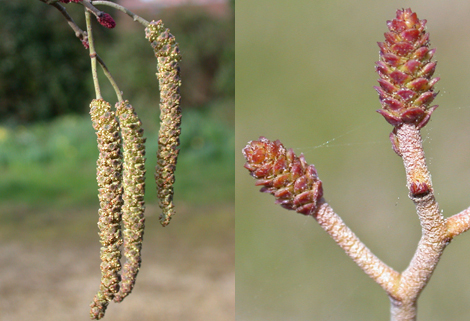 |
Alders
Tall trees, often suckering at the base and typically in wetland habitats or planted as windbreaks. Male catkins long and very mobile, typically hanging in bunches of three to six. Bracts firm and relatively thick, purple, becoming reddish, then yellow as the flowers mature. Female flowers dark red, in tight clusters like tiny pine cones, carried in small, upright, branched clusters near the base of the male catkins. Female structures harden and become woody, remaining on the tree for a least a year. Catkins typically mature in February-March. |
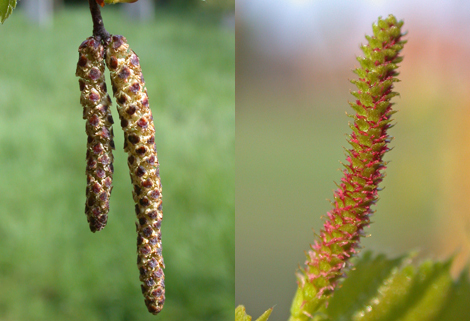 |
Birches
Narrow, upright trees with slender, wiry twigs which are often somewhat pendulous. Male catkins long and very mobile, solitary or in small groups of two to four. Bracts firm and relatively thick, purple, becoming reddish, then yellow as the flowers mature. Female flowers in slender, upright spikes a little further back on the same twig as the male catkins. Female structures become pendulous as they mature, with the three-lobed bracts becoming papery and the whole catkin breaking apart on the tree. Catkins typically mature in April-May. |
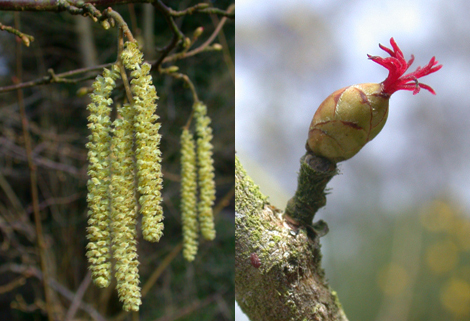 |
Hazels
Multistemmed bushes or hedgerow plants. Male catkins long and very mobile, solitary or in small groups of two to four. Bracts rather thin, reddish but soon becoming yellow as the flowers mature. Female flowers appear as simple clusters of red stigmas, protruding from a swollen base. They can be found a little further back along the twigs from the male flowers. Catkins typically mature in January-March. |
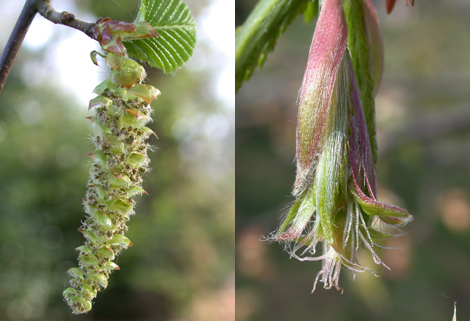 |
Hornbeams
Woodland trees, becoming large and broadly spreading. Male catkins relatively short, hanging solitarily, not in groups. Bracts thin and papery, reddish but soon pale yellow as the flowers mature. Female flowers also in pendulous catkins, but differing from the male catkins in having large, green and reddish bracts that cover the flowers but for the long, white stigmas. Leaves open with the catkins and are simple, with strongly ridged veins and serrated margins. Catkins typically mature in April-May. |
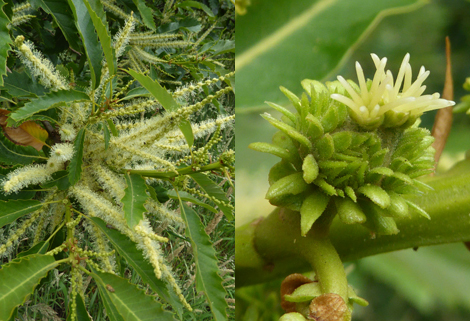 |
Sweet Chestnut
Large, spreading trees in woodland or parkland. Male flowers in catkin-like spikes but carried on stiff stalks and not hanging. The spikes appear in radiating clusters, with the male flowers well spaced and without bracts. Female flowers can be found at the base of the male spikes, either singly or up to three per spike, each with a basal frill of green spikes which will swell to become the casing for the fruits. Catkins typically mature in July. |
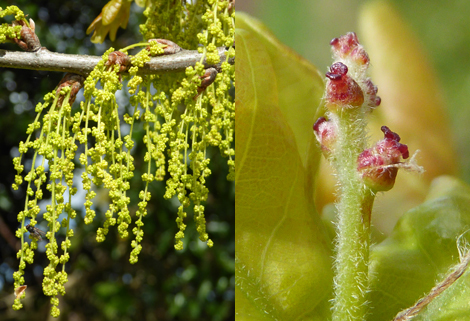 |
Oaks
Large, spreading trees in woodland, parkland, hedgerows and amenity areas. Male flowers in pendulous catkins, hanging in clusters and typically appearing in great quantity as the leaves open (note that there are also evergreen species of oak). The flowers are exposed and not surrounded by bracts. Female flowers solitary or in small clusters, or carried on short, stiff stalks; tiny and consisting of dark red or purplish stigmas above a swollen base. The female flowers appear at nodes a little further back along the twigs than the male spikes. Catkins typically mature in late April-early June, according to species. |
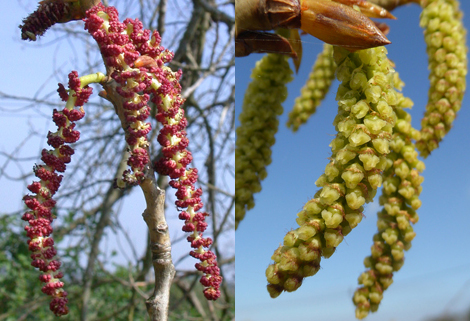 |
Poplars
Large to very large, spreading or columnar trees in parkland, hedgerows and as shelter belts and screens. Male and female catkins on separate trees. Male flowers in pendulous catkins, solitary or in small clusters of two or three. The whole catkin looks red from the colour of the pollen-carrying anthers. Female flowers in longer pendulous catkins, greenish-yellow in colour and typically high up in the crown of the tree and out of reach from the ground (you might need to use binoculars or look around for fallen catkins on the ground after a windy day!). Catkins typically mature in late February-May (April-May for most), according to species, with the female catkins elongating in fruit and producing a mass of white fluff to help distribute the seed by wind. |
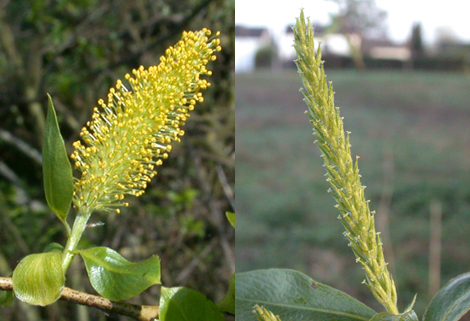 |
Willows & Osiers
Multistemmed shrubs to large trees in most habitats but especially damp areas. Male and female catkins on separate trees. Male flowers in erect or more or less erect catkins, usually solitary. Catkins usually greenish with bright yellow anthers at maturity. Female flowers also in erect catkins, greenish-yellow in colour and tipped with pale stigmas. All flowers have small bracts, leaving the individual flowers clearly visible. Catkins typically mature in April-early June, according to species and opening with the leaves, with the female catkins swelling in fruit and producing a mass of white fluff to help distribute the seed by wind. |
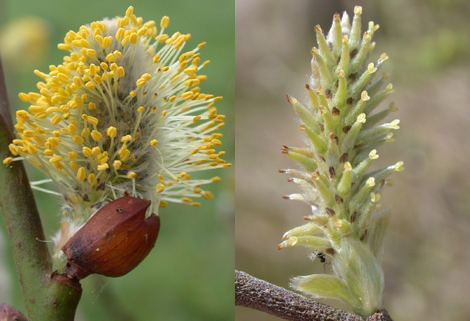 |
Willows & Osiers
Multistemmed shrubs to large trees in most habitats but especially damp areas. Male and female catkins on separate trees. Male flowers in short, erect catkins, usually solitary. Catkins white at first with a thick coating of silky hairs ('pussy willow') with bright yellow anthers at maturity. Female flowers also in erect catkins, greenish-yellow in colour and tipped with pale stigmas. All flowers have small bracts, leaving the individual flowers clearly visible. Catkins typically mature in March-April, before the leaves. |
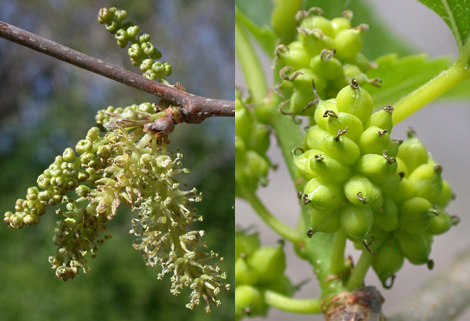 |
Mulberries
Small, ornamental trees, planted in cemeteries and parks. Male catkins short, hanging in small groups; flowers exposed and not covered by bracts. Female flowers in short, rounded catkins, each flower exposed and not hidden by bracts. Male and female catkins carried separately but on the same tree. Leaves open with the catkins and are broadly rounded, often deeply lobed. Catkins typically mature in May-June. |
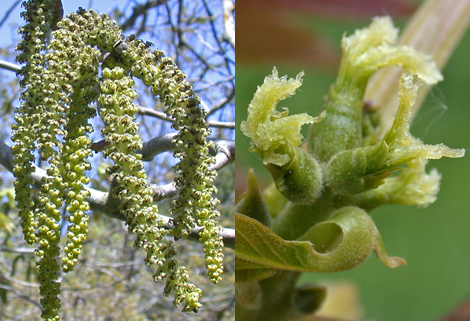 |
Walnuts
Ornamental trees, planted in cemeteries and parks and occasionally on roadsides or in hedges. Male catkins loose and pendulous, hanging in small groups; flowers exposed and not covered by bracts. Female flowers on the same branches as the male flowers in small clusters and consisting of a swollen, green base and two, prominent stigmas. Catkins typically mature in June. This is the only group of catkin-bearing plants on this page that has pinnate leaves. |